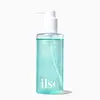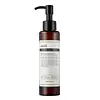What's inside
What's inside
 Key Ingredients
Key Ingredients

 Benefits
Benefits

 Concerns
Concerns

 Ingredients Side-by-side
Ingredients Side-by-side

Cetyl Ethylhexanoate
EmollientEthylhexyl Palmitate
EmollientEthylhexyl Stearate
EmollientPEG-20 Glyceryl Triisostearate
EmollientCarthamus Tinctorius Seed Oil
MaskingOctyldodecanol
EmollientIsododecane
EmollientPolybutene
Water
Skin ConditioningMelia Azadirachta Leaf Extract
Skin ConditioningMelia Azadirachta Flower Extract
Skin ConditioningCoccinia Indica Fruit Extract
Skin ConditioningSolanum Melongena Fruit Extract
Skin ConditioningAloe Barbadensis Flower Extract
EmollientAmber Powder
Curcuma Longa Root Extract
MaskingOcimum Sanctum Leaf Extract
Skin ConditioningCorallina Officinalis Extract
Skin ConditioningMoringa Oleifera Seed Oil
EmollientSimmondsia Chinensis Seed Oil
EmollientMelaleuca Alternifolia Leaf Extract
PerfumingChamomilla Recutita Flower Extract
MaskingCentella Asiatica Extract
CleansingAgave Tequilana Leaf Extract
AstringentBeta Vulgaris Root Extract
Skin ConditioningBrassica Oleracea Capitata Leaf Extract
Skin ConditioningCarica Papaya Fruit Extract
Skin ConditioningDaucus Carota Sativa Root Extract
Skin ConditioningVaccinium Angustifolium Fruit Extract
Skin ProtectingSophora Angustifolia Root Extract
Skin ConditioningPolygonum Cuspidatum Root Extract
AntioxidantPoncirus Trifoliata Fruit Extract
Skin ConditioningSaururus Chinensis Leaf/Root Extract
AntimicrobialCinnamomum Cassia Bark Extract
MaskingSalix Alba Bark Extract
AstringentPEG-10 Glyceryl Isostearate
EmollientTocopherol
AntioxidantSqualane
EmollientButylene Glycol
HumectantPanthenol
Skin ConditioningPropylene Glycol
Humectant1,2-Hexanediol
Skin ConditioningMethylpropanediol
SolventPentylene Glycol
Skin ConditioningOctanediol
Ethylhexylglycerin
Skin ConditioningParfum
MaskingCetyl Ethylhexanoate, Ethylhexyl Palmitate, Ethylhexyl Stearate, PEG-20 Glyceryl Triisostearate, Carthamus Tinctorius Seed Oil, Octyldodecanol, Isododecane, Polybutene, Water, Melia Azadirachta Leaf Extract, Melia Azadirachta Flower Extract, Coccinia Indica Fruit Extract, Solanum Melongena Fruit Extract, Aloe Barbadensis Flower Extract, Amber Powder, Curcuma Longa Root Extract, Ocimum Sanctum Leaf Extract, Corallina Officinalis Extract, Moringa Oleifera Seed Oil, Simmondsia Chinensis Seed Oil, Melaleuca Alternifolia Leaf Extract, Chamomilla Recutita Flower Extract, Centella Asiatica Extract, Agave Tequilana Leaf Extract, Beta Vulgaris Root Extract, Brassica Oleracea Capitata Leaf Extract, Carica Papaya Fruit Extract, Daucus Carota Sativa Root Extract, Vaccinium Angustifolium Fruit Extract, Sophora Angustifolia Root Extract, Polygonum Cuspidatum Root Extract, Poncirus Trifoliata Fruit Extract, Saururus Chinensis Leaf/Root Extract, Cinnamomum Cassia Bark Extract, Salix Alba Bark Extract, PEG-10 Glyceryl Isostearate, Tocopherol, Squalane, Butylene Glycol, Panthenol, Propylene Glycol, 1,2-Hexanediol, Methylpropanediol, Pentylene Glycol, Octanediol, Ethylhexylglycerin, Parfum
Caprylic/Capric Triglyceride
MaskingCetyl Ethylhexanoate
EmollientIsononyl Isononanoate
EmollientPEG-7 Glyceryl Cocoate
EmulsifyingIsopropyl Myristate
EmollientSimmondsia Chinensis Seed Oil
EmollientGlycine Soja Oil
EmollientSesamum Indicum Seed Oil
EmollientRibes Nigrum Seed Oil
EmollientTocopheryl Acetate
AntioxidantPEG-20 Glyceryl Triisostearate
EmollientPolysorbate 20
EmulsifyingParfum
MaskingButyrospermum Parkii Butter
Skin ConditioningCarapa Guaianensis Seed Oil
Skin ConditioningVaccinium Macrocarpon Seed Oil
Skin ConditioningCaprylic/Capric Triglyceride, Cetyl Ethylhexanoate, Isononyl Isononanoate, PEG-7 Glyceryl Cocoate, Isopropyl Myristate, Simmondsia Chinensis Seed Oil, Glycine Soja Oil, Sesamum Indicum Seed Oil, Ribes Nigrum Seed Oil, Tocopheryl Acetate, PEG-20 Glyceryl Triisostearate, Polysorbate 20, Parfum, Butyrospermum Parkii Butter, Carapa Guaianensis Seed Oil, Vaccinium Macrocarpon Seed Oil
 Reviews
Reviews

Ingredients Explained
These ingredients are found in both products.
Ingredients higher up in an ingredient list are typically present in a larger amount.
Cetyl Ethylhexanoate is an emollient ester. It comes from cetearyl alcohol and 2-ethylhexanoic acid.
Cetyl Ethylhexanoate is an emollient that adds a velvety feel to skin without being greasy or oily. Emollients help trap moisture into your skin, keeping your skin soft and hydrated.
Parfum is a catch-all term for an ingredient or more that is used to give a scent to products.
Also called "fragrance", this ingredient can be a blend of hundreds of chemicals or plant oils. This means every product with "fragrance" or "parfum" in the ingredients list is a different mixture.
For instance, Habanolide is a proprietary trade name for a specific aroma chemical. When used as a fragrance ingredient in cosmetics, most aroma chemicals fall under the broad labeling category of “FRAGRANCE” or “PARFUM” according to EU and US regulations.
The term 'parfum' or 'fragrance' is not regulated in many countries. In many cases, it is up to the brand to define this term.
For instance, many brands choose to label themselves as "fragrance-free" because they are not using synthetic fragrances. However, their products may still contain ingredients such as essential oils that are considered a fragrance by INCI standards.
One example is Calendula flower extract. Calendula is an essential oil that still imparts a scent or 'fragrance'.
Depending on the blend, the ingredients in the mixture can cause allergies and sensitivities on the skin. Some ingredients that are known EU allergens include linalool and citronellol.
Parfum can also be used to mask or cover an unpleasant scent.
The bottom line is: not all fragrances/parfum/ingredients are created equally. If you are worried about fragrances, we recommend taking a closer look at an ingredient. And of course, we always recommend speaking with a professional.
Learn more about ParfumPeg-20 Glyceryl Triisostearate comes from Isostearic Acid and glycerin.
It is an emollient, emulsifier, and gentle cleanser. As an emollient, it helps trap moisture to keep skin soft and hydrated. Emulsifiers help prevent ingredients from separating.
This ingredient is common in oil-based products. This is because it helps oil-ingredients be easily washed away without leaving a residue.
Peg-20 Glyceryl Triisostearate may not be fungal-acne safe.
Learn more about PEG-20 Glyceryl TriisostearateThis oil comes from the seeds of the desert shrub called Jojoba. It is more commonly known as jojoba oil, a non-comedogenic oil.
Jojoba oil does not contain fragrance and has many fatty-acids, making it a great soothing ingredient.
It also contains Vitamin E, a great moisturizing ingredient. Vitamin E is also an antioxidant and protects your skin against oxidative damage.
This ingredient humectant properties, meaning it helps draw moisture from the air. This helps keep your skin hydrated.
While jojoba has antibacterial properties, it is only able to kill some strains of bacteria.
Studies also show it helps in wound healing. In fact, Indigenous cultures have used jojoba as a moisturizer and to help treat burns for centuries.
Fun fact: Jojoba oil similar to natural human skin sebum, so it has a great effect on dry skin. It is also promising with helping to regulate sebum production.
Due to its fatty acid content, Jojoba oil may not be fungal acne safe. We recommend speaking with a professional if you have any concerns.
Learn more about Simmondsia Chinensis Seed Oil